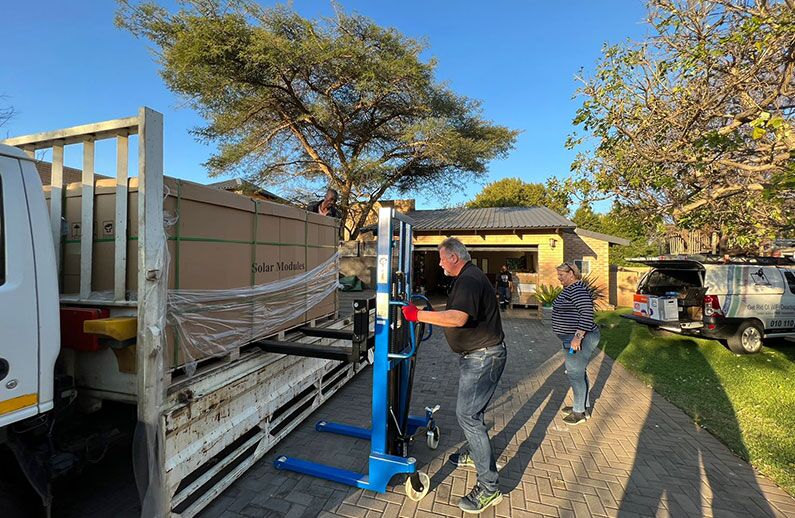Wie können Hühnerställe, Scheunen und landwirtschaftliche Geräte in abgelegenen Gebieten mit Solarenergie betrieben werden?
May 21, 2025
Für Landwirte und Landbesitzer ist ein zuverlässiger Zugang zu Energie entscheidend für die Gesundheit ihres Viehbestands, den Betrieb ihrer Geräte und die Gewährleistung ihrer Betriebseffizienz. Solarenergie bietet eine nachhaltige Lösung, insbesondere für abgelegene landwirtschaftliche Betriebe, in denen ein Netzanschluss unpraktisch oder teuer ist. Dieser Leitfaden untersucht praktische Strategien für solarbetriebene Farmen und konzentriert sich dabei auf moderne Modultechnologien wie N-Typ-Halbzellenmodule, bifaziale 580-W-Solarmodule und Doppelglas-Solarmodule, die Langlebigkeit, Effizienz und langfristigen Wert vereinen.1. Ermittlung des Energiebedarfs landwirtschaftlicher BetriebeBevor Sie eine Solaranlage planen, berechnen Sie den Energiebedarf Ihres Hühnerstalls, Stalls oder Ihrer landwirtschaftlichen Geräte. Heizlampen, Ventilatoren, Futterautomaten und Wasserpumpen benötigen je nach Größe typischerweise 1–5 kWh pro Tag. Beispielsweise benötigt ein mittelgroßer Geflügelbetrieb mit 200 Hühnern möglicherweise eine Anlage mit 3–4 kW. N-Typ Halbschnitt-Solarmodule sind hier aufgrund ihrer höheren Effizienz (22 %+) und des geringeren Leistungsverlusts bei teilweiser Beschattung ideal und gewährleisten eine konstante Leistung, selbst wenn die Paneele teilweise durch landwirtschaftliche Strukturen oder Laub verdeckt werden.2. Die richtige Solarpanel-Technologie wählenLandwirtschaftliche Umgebungen erfordern robuste Solarlösungen. Doppelglas-Solarmodule mit beidseitig gehärtetem Glasrahmen bieten außergewöhnlichen Schutz gegen Feuchtigkeit, Ammoniakkorrosion (häufig in Geflügelfarmen) und mechanische Einflüsse wie Hagel oder Trümmer. Ihre Lebensdauer von über 30 Jahren macht sie zu einer kostengünstigen Wahl für Scheunendächer. Für bodenmontierte Anlagen in der Nähe von Viehtränken oder Bewässerungssystemen können bifaziale 580-W-Solarmodule bis zu 20 % mehr Energie erzeugen, indem sie reflektiertes Sonnenlicht vom Boden einfangen und so die Leistung in der Hochsaison maximieren.3. Systemdesign für raue UmgebungenLandwirtschaftliche Anlagen stehen vor besonderen Herausforderungen: Staub, extreme Temperaturen und häufiges Bewegen der Geräte. Ein Hybridsystem aus N-Typ-Halbzellenmodulen (für Dachanlagen) und bifazialen Modulen (für Freiflächenanlagen) optimiert Platz und Energieertrag. Für abgelegene Anlagen wie elektrische Zäune oder Wasserpumpen kombinieren Sie die Module mit Lithium-Ionen-Batterien, die für den Einsatz mit tiefen Zyklen geeignet sind. Stellen Sie sicher, dass alle Komponenten die Schutzart IP65 oder höher aufweisen, um Staub und Feuchtigkeit standzuhalten.4. Best Practices für Installation und WartungObwohl Solaranlagen in Eigenregie möglich sind, empfiehlt sich für Scheunen und Hühnerställe eine professionelle Installation, um die strukturelle Sicherheit und die Einhaltung der örtlichen Vorschriften zu gewährleisten. Montieren Sie die Module mit einer Neigung von 10–30° für einen selbstreinigenden Regenwasserablauf. Doppelglas-Solarmodule Aufgrund ihrer porenfreien Oberfläche ist nur minimaler Wartungsaufwand erforderlich. Es wird jedoch empfohlen, vierteljährlich auf Schmutz oder Schatten zu prüfen. Achten Sie bei bifazialen 580-W-Modulen auf eine klare, reflektierende Bodenoberfläche (z. B. hellen Kies), um die Energieproduktion auf der Rückseite zu verbessern.5. Kosteneinsparungen und AnreizeEine 5-kW-Solaranlage mit N-Typ-Halbzellenmodulen kann die jährlichen Energiekosten eines landwirtschaftlichen Betriebs um 60–80 % senken. In sonnenreichen Regionen beträgt die Amortisationszeit 6–8 Jahre. Viele Regierungen bieten Fördermittel für landwirtschaftliche Solaranlagen an, beispielsweise das REAP-Programm des US-Landwirtschaftsministeriums (USDA), das bis zu 25 % der Installationskosten deckt. Darüber hinaus kann der höhere Energieertrag bifazialer Module den ROI beschleunigen, insbesondere bei der Versorgung anspruchsvoller Geräte wie Melkmaschinen oder Getreidetrockner.6. Praxisanwendungen und ZuverlässigkeitEin praktisches Beispiel für den Erfolg von Solarenergie ist das 26-kW-Solarkraftwerk in Kamerun (Installation am 17. Mai 2022). Der Betrieb litt aufgrund der unzuverlässigen Netzinfrastruktur unter häufigen Stromausfällen, die den täglichen Betrieb beeinträchtigten. Durch die Implementierung eines 26-kW-Systems mit 580 W bifaziale Solarmodule Dank der Doppelglas-Solarmodule erreichte der Betrieb Energieunabhängigkeit. Die bifazialen Module nutzten das vom Boden reflektierte Sonnenlicht, während die Doppelglaskonstruktion witterungsbeständig und korrosionsbeständig war. Nach der Installation berichtete der Kunde von einer deutlichen Reduzierung der Ausfallzeiten und Betriebskosten.Die Umstellung auf Solarenergie für die Landwirtschaft ist kein Nischenkonzept mehr, sondern eine praktische und finanziell sinnvolle Entscheidung. Durch den Einsatz von Technologien wie N-Typ-Halbzellenmodulen für hohe Effizienz, bifazialen 580-W-Solarmodulen für leistungsstarke Freilandanlagen und langlebigen Doppelglas-Solarmodulen können Landwirte Energieunabhängigkeit erreichen und gleichzeitig ihre Rentabilität sichern. Beginnen Sie mit einem Energieaudit, konsultieren Sie zertifizierte Installateure und informieren Sie sich über regionale Fördermöglichkeiten, um ein System zu entwickeln, das auf die individuellen Anforderungen Ihres Betriebs zugeschnitten ist.


 NETZWERK UNTERSTÜTZT
NETZWERK UNTERSTÜTZT